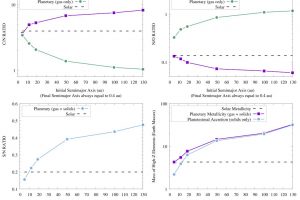The properties of the exoplanets sculpted by the forming environment. The study: “Exploring the link between star and planet formation with Ariel” of D. Turrini (INAF-IAPS) appeared on Experimental Astronomy

To date (October 2021, data from https://exoplanets.nasa.gov/), astronomer discovered enough exoplanets (in excess of 4500) to allow not only analysis of individual planets, but also detailed studies of the whole exoplanets population. These studies are necessary to fully understand the process of planets formation, the evolution of planets, the chemical composition and physical properties of planets atmospheres, and how the forming environment can shape the properties of the planets. The study of the chemical composition of the planetary atmospheres is the objective of the satellite ARIEL, the M4 class mission of the European Space Agency (ESA), whose launch is scheduled on 2029.
ARIEL observations of the chemical composition of hundreds of exoplanets, mainly gaseous planets, will not only constitute a milestone for our knowledge of individual planets, but it will also provide for the first time detailed chemical measurements for a rich and variegate sample of exoplanets. In particular, one of the “working group” led by the astronomer D. Turrini (INAF – Institute of Space Astrophysics and Planetology and INAF – Astrophysical Observatory of Turin) aims at understanding how the formation process and the interaction between the young exoplanets and the surrounding environment shape the final properties of exoplanets.
Planets, in fact, form in discs of gas and dust called “protoplanetary discs”, which are typically observed orbiting around very young stars and whose evolution and chemical properties can be affected by the stellar surrounding environment. Besides, chemical composition and physical properties of discs change drastically as a function of the distance from the central star. This is crucial since young planets can change their orbits as a consequence of the interaction with the disc material and other planets in the system. Because of this radial migration, planets can accrete both material and other planetesimals (which are solid bodies first products of the planetary formation) with different chemical properties, and this can affect the final composition of planets and their atmospheres. Even the central star can play an important role in shaping the properties of exoplanets, mainly those in close orbits, as a consequence of the magnetic phenomena which result in emission of energetic radiation (X and UV ray) and charged particles. The paper “Exploring the link between star and planet formation with Ariel” of D. Turrini, recently appeared on the journal Experimental Astronomy, describes the importance of both the environment and the migration processes in sculpting planetary properties, and how ARIEL observations will help astronomers in shading some light on this.
The figure (click here to visualize the entire image) shows the ratio of the abundances carbon and nitrogen (C/N), nitrogen and oxygen (N/O), sulphur and nitrogen (S/N) for gaseous planets as predicted by theoretical models. Planets experience a disk-induced migration until they become “hot Jupiters” (hot gaseous exoplanets in very close orbits). Dashed horizontal lines mark the stellar abundances. The lines show the abundance ratios both in the case the planets accrete only gas and both gas and solid bodies. The bottom right panel also compares the total accreted mass with that of the planetesimals. These diagrams demonstrate how the determination of abundances ratio allow astronomers to study the planets formation process and planetary migration.
Mario Giuseppe Guarcello ( follow mguarce) ( youtube)
Subscribe the Youtube channel of the Astronomical Observatory of Palermo
